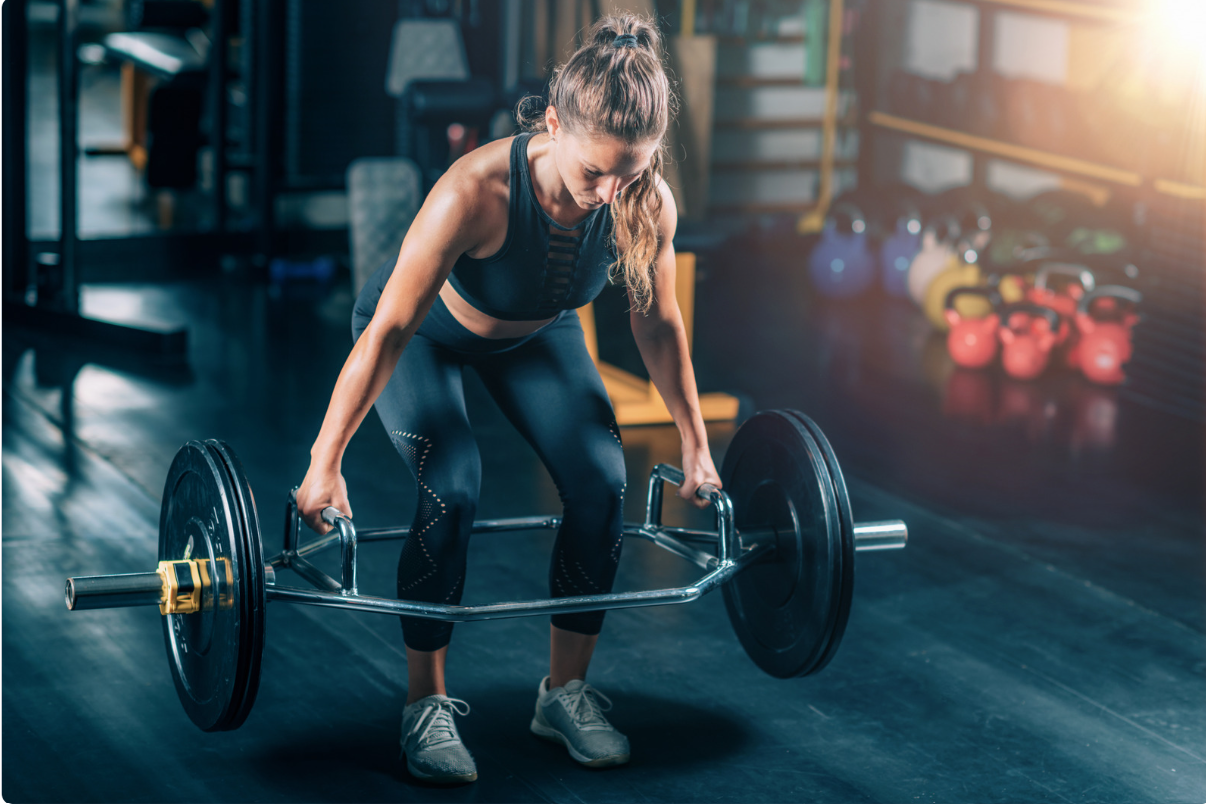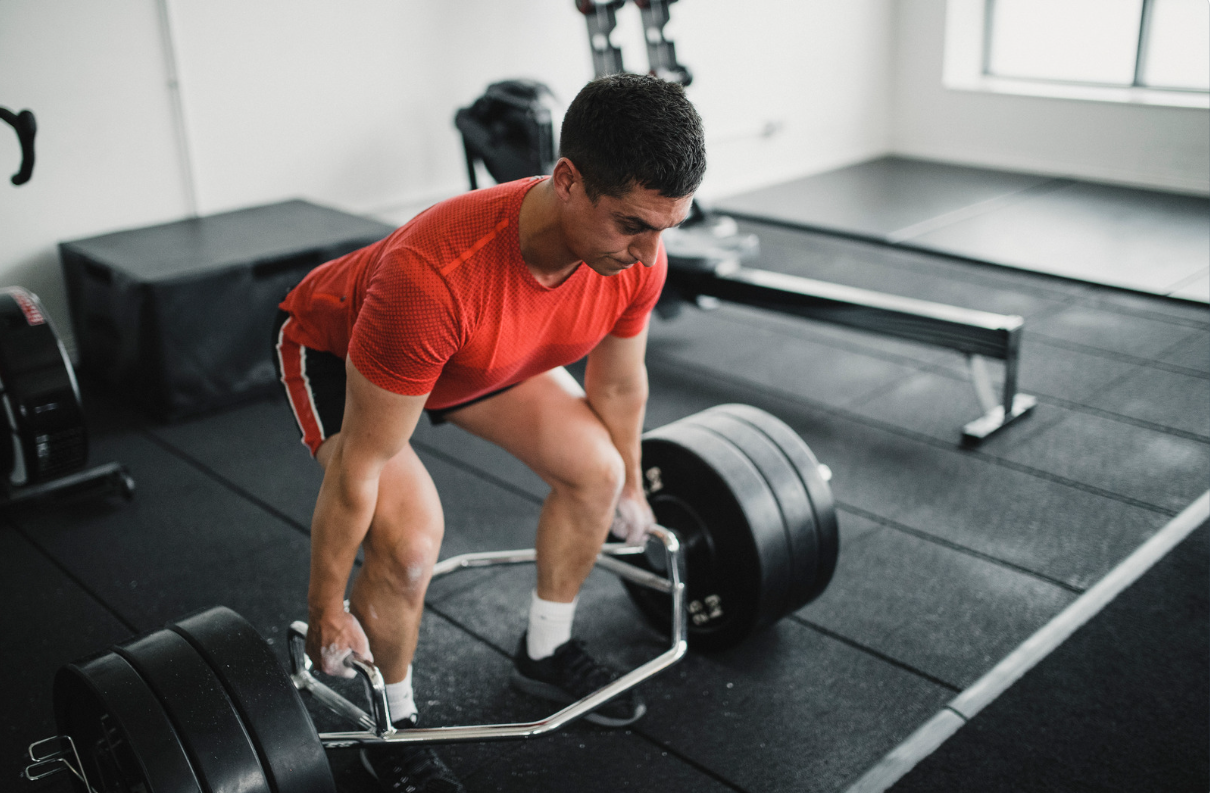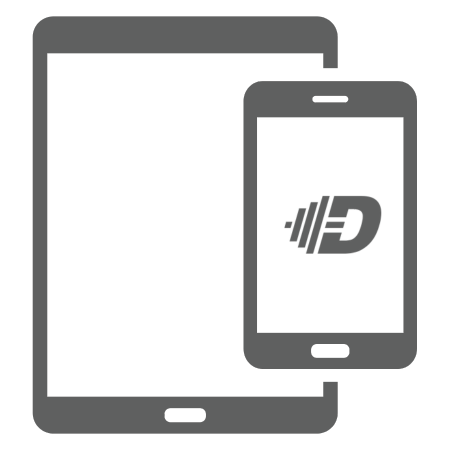If you’re looking for a way to deadlift that challenges your glutes more and doesn’t put so much strain on your lower back, trap bar deadlifts might just be for you. As an alternative deadlift, trap bar deadlifts still target muscles throughout the entire body and offer similar benefits to the traditional exercise, but they’re often easier for beginners due to the trap bar’s design.
Whether you’re trying to switch up your workout routine or are starting a new one from scratch, our guide to trap bar deadlifts can help you decide if they’re right for you.
What Is a Trap Bar?
Also called a hex bar, a trap bar is a hexagonal-shaped barbell that allows the lifter to stand inside the frame.
The unique design enables the user to take hold of handles positioned at their sides with a neutral grip (palms facing each other), rather than in front of them as with a traditional barbell.
The trap bar typically features two sets of handles: low handles for a deeper squat-like position and high handles for a more upright posture. If you have mobility issues or are a beginner, stick to using the high bar handles as they reduce your needed range of motion and make getting into the starting position easier.
The trap bar’s hex shape and its handles’ position help center the load around the lifter’s body, reducing stress on the lower back and promoting a more natural lifting form. Alongside being used for deadlifts, hex bars are regularly used for shrugs, overhead presses, farmer’s walks, squats, and lunges.

Trap Bar Deadlift Vs. Conventional Deadlifts
Trap bar deadlifts and conventional deadlifts differ in several key ways.
In terms of form, the trap bar allows for a more upright posture, with the bar surrounding the lifter’s body. This design makes trap bar deadlifts easier on the joints and more beginner-friendly. The conventional deadlift, on the other hand, requires a deeper hip hinge and knee flexion, focusing more on the posterior chain (muscles on the back of your body).
Grip is another key difference, as trap bars use a neutral grip, which is more comfortable and reduces grip strain, while conventional deadlifts rely on an overhand grip.
Additionally, the trap bar’s weight distribution allows for heavier loads, making it ideal for maximizing strength with a lower injury risk.
Lastly, trap bar deadlifts engage the quads and glutes more, whereas conventional deadlifts target the hamstrings and lower back more intensively.
Why Are Hex Bar Deadlifts Good For You? The Top 5 Trap Bar Deadlift Benefits
Trap bar deadlifts are an excellent alternative to traditional deadlifts, offering several benefits that make them ideal for many people’s strength training routines. If you’re on the fence about adding this exercise to your routine, check out the following five primary trap bar deadlift benefits:
- Reduced stress on the lower back: The trap bar deadlift places less strain on the lumbar spine compared to traditional deadlifts. Its design encourages a more upright torso position, which helps reduce lower back tension, making it a safer alternative for those with back issues or those new to lifting.
- Better form for beginners: The trap bar’s neutral grip and centered design make it easier to maintain proper form, especially for those struggling with the traditional straight bar deadlift. The more natural body mechanics make it an excellent choice for newcomers to weightlifting.
- Increased leg and glute activation: Unlike conventional deadlifts, the trap bar deadlift shifts more focus onto the quadriceps and glutes due to its more upright position. This shift in focus makes it an ideal movement for those looking to develop these lower-body muscles, especially when performing at angles above parallel.
- Ability to lift heavier weights: Many lifters find they can handle heavier loads with the trap bar due to its advantageous positioning. For example, one study found that the average one rep maximum of weightlifters was 539 lbs for a conventional deadlift and 265 lbs for trap bar deadlifts. The more favorable center of gravity allows you to lift more than you could with a traditional barbell, making it a great tool for strength development.
- Versatile for various training goals: The trap bar deadlift can be used to enhance overall strength, aid in hypertrophy, and serve as a supplemental lift for Olympic weightlifters. Its versatility allows it to fit into different training regimens, from building foundational strength to improving performance in other lifts.
How to Safely Perform a Trap Bar Deadlift
Getting all the benefits of trap bar deadlifts starts with knowing how to do them properly and safely. With the right trap bar deadlift form, you can avoid injury and strengthen your muscles more effectively. Review the following steps for properly performing a hex bar deadlift below:
- Set Your Starting Position: Stand inside the trap bar with your feet shoulder-to-hip-width apart and your weight distributed evenly. Align your shins directly over or slightly in front of the center of the bar. Next, keep your posture tall with a slight bend in your knees and ensure your shoulders are directly above your hips. Finally, tuck your chin in, and keep it in this tucked position throughout the entire exercise.
- Engage Your Core: Deeply Inhale and exhale while bracing your core, hips, and shoulders.
- Hinge at the Hips: Push your hips back and bend your knees to lower your body towards the trap bar handles. Maintain a neutral spine and keep your back flat as you lower your torso.
- Grip the Handles: Reach down and grasp the trap bar handles. Engage your back muscles by rotating your arms so your inner elbows are facing forward. Make sure your grip is firm.
- Set Your Body Position: Lift your hips to the point where you feel a stretch in your hamstrings. Ensure your shins are in a vertical position and that your hips are higher than your knees.
- Lift the Bar: Keeping a neutral spine, initiate the lift by driving your feet into the floor. Push through your heels and squeeze your glutes to stand up. As you rise, make sure your hips travel forward. To maintain proper trap bar deadlift form, imagine that you’re tilting your pelvis like a bucket of water, keeping the water level balanced.
- Stand Tall at the Top: At the top of the lift, stand tall with your shoulders directly over your hips and maintain your neutral spine position. Continue to squeeze your glutes at the peak of the movement.
- Lower the Bar: Begin the descent by pushing your hips back, maintaining a neutral spine throughout. Bend your knees as you control the bar’s movement toward the floor.
- Complete the Rep: Once the weight reaches the floor or your hands reach mid-shin, the repetition is complete. If you’re using a trap bar without weight plates, lower it until your hands are at shin height.
We’d recommend starting this workout without any plates on the trap bar, as the lack of extra weight will increase safety and allow you to focus on mastering proper form.
What Muscles Do Trap Bar Deadlifts Target?
Trap bar deadlifts offer a full-body exercise that works most of your body, much like a traditional deadlift. However, the trap bar deadlift does affect your muscles a bit differently, targeting your glutes, quads, and upper back more than standard deadlifts.
Learn more about the primary muscles worked by trap bar deadlifts and how they differ from conventional deadlifts below:
1. Glutes
The glutes are heavily engaged during the trap bar deadlift. The more upright posture allows for optimal hip extension, which helps to target the glutes more effectively than a conventional deadlift. This position maximizes the glute contraction on each rep, promoting overall lower-body strength and power.
2. Hamstrings
The hamstrings are worked during the trap bar deadlift, but their activation is slightly less than in a conventional deadlift. Due to the increased knee flexion in the trap bar setup, the hamstrings aren’t as heavily stressed. Keep in mind, however, that your hamstrings still play a primary role in stabilizing the lift and assisting with hip extension.
3. Quads
The quadriceps experience a greater degree of activation in the trap bar deadlift compared to the conventional deadlift. The increased knee flexion from the trap bar setup shifts some of the work to the quads, which are responsible for extending the knee and assisting in the lift. This increase in knee movement makes the trap bar deadlift more knee-dominant than other variations.
4. Lower Back
The erector spinae, or lower back muscles, are activated during the trap bar deadlift, but to a lesser extent compared to a conventional deadlift. Because of the more neutral spine position in the trap bar setup, there is less strain placed on the lower back, making it a safer option for those with lower back concerns.
5. Upper Back
The trapezius and upper back muscles are engaged to stabilize the shoulders and maintain an upright posture during the lift. While the activation is similar to conventional deadlifts, the trap bar deadlift’s more vertical torso position places more emphasis on the middle and upper back muscles, making them work harder to control the movement.
6. Core Muscles
The core muscles, including the rectus abdominis, obliques, and transverse abdominis, are actively engaged in stabilizing the body throughout the trap bar deadlift. While the core still plays a significant role, the more upright position of the trap bar reduces the demand on the core muscles compared to traditional deadlifts.
7. Forearms and Grip
Throughout an entire trap bar deadlift rep, the forearms and grip are continually engaged to maintain a secure hold on the handles of the trap bar. The neutral grip provided by the trap bar reduces wrist strain and makes the grip more comfortable compared to a traditional deadlift, while still requiring substantial forearm strength to control heavier loads.
How Much Do Trap Bars Weigh?
Traps bars usually weigh between 45 and 70 pounds, with some Olympic bars weighing up to 80 pounds.
The reason for the varying weights is due to a lack of standardized trap bar dimensions, meaning a trap bar from one brand may weigh differently from another. As a result, it’s essential to check the trap bar’s weight before you work out with one to make sure you know how much you’re actually lifting.
Begin Trap Bar Deadlifting at Defined Fitness
If you’re interested in receiving the benefits of trap bar deadlifts, Defined Fitness has you covered. With a wide selection of traditional barbells and hex bars, you can easily work in sets of trap bar deadlifts at our gyms. Our personal trainers can also help you practice proper form and get the most out of any exercise you perform with a trap bar.
Learn more about our membership options today. If you’re ready to start deadlifting with a trap bar, check out our many gym locations in New Mexico.




